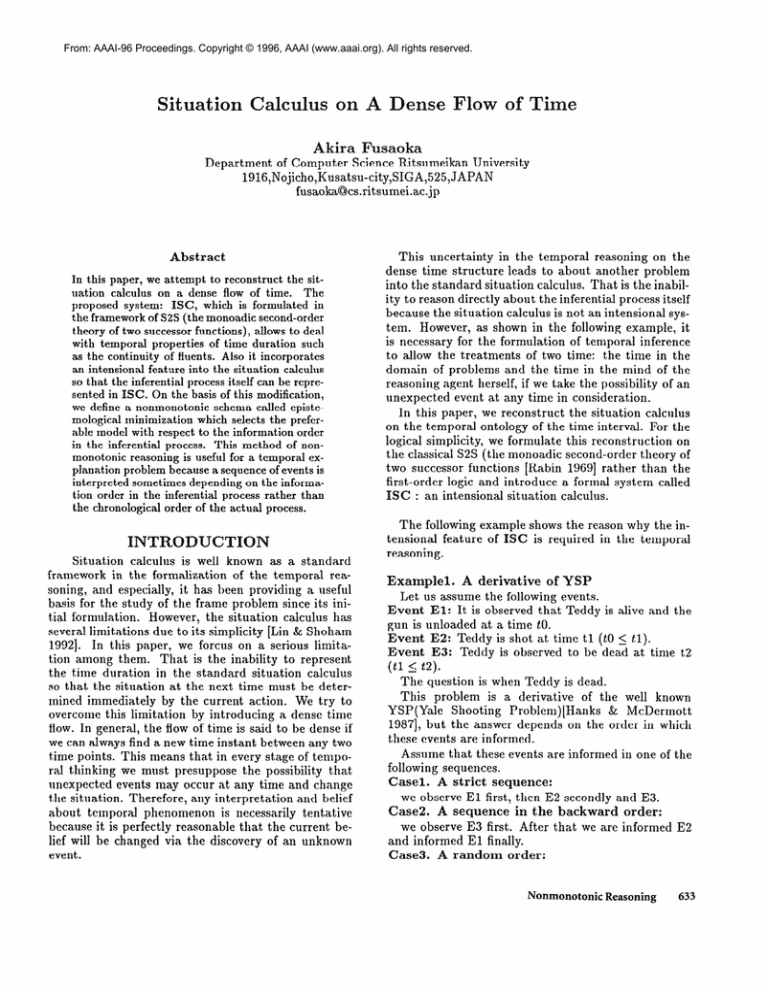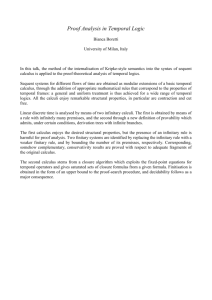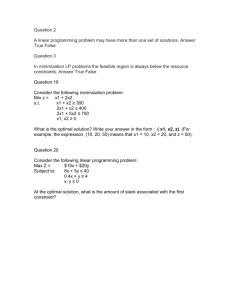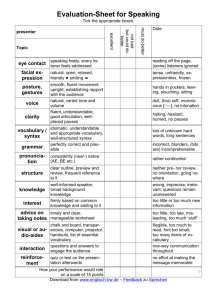
From: AAAI-96 Proceedings. Copyright © 1996, AAAI (www.aaai.org). All rights reserved.
Situation
Calculus
on A Dense
Flow of Time
Akira F’usaoka
Department of Computer Science Ritsumeikan University
1916,Nojicho,Kusatsu-city,SIGA,525,JAPAN
fusaoka@cs.ritsumei.ac.jp
Abstract
In this paper, we attempt
to reconstruct
the situation calculus on a dense flow of time.
The
INTRODUCTION
Situation calculus is well known as a standard
framework in the formalization of the temporal reasoning, and especially, it has been providing a useful
basis for the study of the frame problem since its initial formulation. However, the situation calculus has
several limitations due to its simplicity [Lin & Shoham
19921. In this paper, we forcus on a serious limitation among them. That is the inability to represent
the time duration in the standard situation calculus
so that the situation at the next time must be determined immediately by the current action. We try to
overcome this limitation by introducing a dense time
flow. In general, the flow of time is said to be dense if
we can always find a new time instant between any two
t#imepoints. This means that in every &age of temporal thinking we must presuppose t,he possibility that
unexpected events may occur at any time and change
the situation. Therefore, any interpretation and belief
about temporal phenomenon is necessarily tentative
because it is perfectly reasonable that the current belief will be changed via the discovery of an unknown
event.
This uncertainty in the temporal reasoning on the
dense time structure leads to about another problem
into the standard situation calculus. That is the inability to reason directly about the inferential process itself
because the situation calculus is not an intensional system. However, as shown in the following example, it
is necessary for the formulation of temporal inference
to allow the treatments of two time: the time in the
domain of problems and the time in the mind of the
reasoning agent herself, if we take the possibility of an
unexpected event at any time in consideration.
In this paper, we reconstruct the situation calculus
on the temporal ontology of the time interval. For the
logical simplicity, we formulate this reconstruction on
the classical S2S (the monoadic second-order theory of
two successor functions [Rabin 19691 rather than the
first-order logic and introduce a formal system called
ISC : an intensional situation calculus.
The following example shows the reason why the intensional feature of ISC is required in the temporal
reasoning.
Examplel. A derivative of Y SP
Let us assume the following events.
Event El: It is observed that Teddy is alive and the
gun is unloaded at a time to.
Event E2: Teddy is shot at time tl (to 5 tl).
Event E3: Teddy is observed to be dead at time t2
(t1 5
t2).
The question is when Teddy is dead.
This problem is a derivative of the well known
YSP(Yale Shooting Problem)[Hanks & McDermott
19871, but the answer depends on the order in which
these events are informed.
Assume that these events are informed in one of the
following sequences.
Casel. A strict sequence:
we observe El first, then E2 secondly and E3.
Case2. A sequence in the backward order:
we observe E3 first. After that we are informed E2
and informed El finally.
Case3. A random order:
Nonmonotonic Reasoning
633
We observe El first and then E3 secondly. After that
we are informed E2 finally.
In the easel, we hold the belief after the first observation that Teddy is alive and the gun is unloaded,
so that we infer the shooting at the time tl does
not change the state of Teddy. Consequently, Teddy
is believed to be alive immediately before the event
E3 which informs that he is dead. Then, what time
structure do we build in the mind to explain this series of events consistently after we find the event E3?
The most reasonable time structure, the solutionl, is
formed on the assumption that Teddy was killed in certain unexpected incident between tl and t2. Another
interpretation, the solution2, is an explanation on the
assumption that the gun had been loaded by an unnoticed event between t0 and tl so that the shooting
at tl caused Teddy to be dead. This time structure is
possible but seems to be unnatural in this case.
On the contrary, we prefer the solution2 to the solutionl for the case2. In this case, we initially believe
from the first obsevation of E3 that Teddy was dead
from tl to t2. Because we have no knowledge about
the state of the gun in this stage of inference, we have
two preferable solutions. The first is the solution2, in
which Teddy was dead as the result of the shooting.
The second is the solution3 in which Teddy had been
dead already before the shooting. However, the solutionl is unnatural in this case.
For the case3, all of the solutions give the comparably preferable interpretation.
This difference in the preference of the solutions is
based on the simple reason that we usually avoid the
annoying update of the already constructed belief in
the inferential process.
This example reveals that the temporal structure
and its interpretation for a sequence of events depends
not only on the temporal order but also the epistemological order in which each event is recognized.
However, this example brings about yet another frame
problem because some difficulties arise in attempts to
deal with this example in the usual nonmonotonic logits, even in the methods proposed to solve YSP [Hanks
& McDermott 19871.
Intensional
Situation
Calculus
: ISC
2.1 Time Structure
ISC is based upon a constructive time structure,
which is built from an interval by iterating the interval
division everytime new event is treated in the process of
temporal inference. So that the time structure is represented with a binary tree of which node corresponds to
an interval and the left and the right successors of the
node correspond to the intervals before and after the
occurrence of the event in that interval, respectively.
Definition 1. Temporal structure
Let U be the set of all finite sequences of O’s and
1’s. Namely, U = (O,l)*.
U can be diagramed as a
634
KnowledgeRepresentation
binary tree. We denote the parent node of x by ox,
the successor nodes of x by x0,x1, and the length of x
by W.
We introduce two order relations in U.
(i) an epistemological order : Let a, b denote the elements of U. Define a 5 b iff a is an initial segment of
b.
(ii) a temporal order : Let a, b denote the elements
of U. A temporal order a 5 b is defined by a 5 b iff
(32)[20 g a A zl s b]
A subset V : V C U is called a subtree if and only
if
(Vx)[x E v --+ ox E V] A [x0 E v iff xl E V]
A maximal linearly ordered subset of the tree U is
called a branch of U. Since a branch is a decreasing sequence of intervals, it has a limitting point in (0, l}w,
which corresponds to the time instant.
Definition 2. S2S
S2S (second-order theory of two successors) has the
usual logical connectives and quantifiers for the variables x, y, . .. ranging over elements of {O,l}*. It contains also the set variables X, Y, . ...and their quantifier
ranging over the subsets of { 0, l}* and the membership relation e. Terms are obtained from the individual variables and a constant E by ‘application of the
successor functions. Atomic formulas are of the form
teT1 = ter2, terl E ter2, terl E X where terl, ter2 are
terms and X is a set variable. The S2S-formula is generated from atomic formulas by the logical connectives
and quantifiers ranging over both the individual and
the set variables.
The most important feature of the S2S is decidability. Namely,
Rabin’s Tree Theorem [Rabin 19691
The (monoadic) second order theory of infinite binary tree is decidable.
The S2S theory has been widely used to study the
dynamic logic and the temporal logic. Especially, the
satisfiability of some tree based modal logics has been
shown to be decidable based on Rabin’s Tree Theorem
[Thomas 19901. Conversely, ISL can be formulated in
the modal logic.
Definition 3. Temporal topology
Let x be an element of 27. We define the subsets (x
and x) of U by
(x = {Zlop ] p 2 0)
if x = zlOQ for some z E {O,l}* and q 2 0
= (OP ] p > 0) elsewhere
2) = (ZOlP ] p 2 0)
if z = zOlq for some 2; E (0, l}* and Q 2 0
= { lp ] p 2 0) elsewhere
[xl= iY I 37c
Y}
Note that these sets are definable by the S2Sformulas.
As known well, we can introduce a topology into the
tree U by the definition that [z] is a neighbor of x. A
open set is also defined by the S2S formula. Namely,
a set Q is open if and only if (Vx)[x E Q + [x] E Q]
2.2 ISC
We present a formal treatment of ISC by using
S2S, which is a reconstruction of the situation calculus
on the interval ontology. First, we transform the elementaly objects of the situation calculus such as fluent,
action and situation, into the subsets of U. Namely, a
fluent p is represented by the set P E U such that
(Vx)[z E P + a fluent p holds in the interval x]
Note that U - P also treated as a not-P fluent.
Similarly, we use the set A instead of an action a where
(Vx)[x E A + an action u is performed in the interval
Xl
A situation is simply corresponding to the set (x or x).
Secondly we define a predicate Hold, which is also
defined by;
How?
(4 = (VY)IY E ( x --$ (W[Y
HoZd(P,x))
A subtree V E U is called a temporal domain of
IS C-system if
V~={~}~{xO,x1~x~A;of
2)
U {X0,X1
IX E CPi Of c”p)
Note that an event (either a clipping of a fluent or an
action ) occurs only in the element of the subset V,
that is,
vxEU(x~V-+[x]EPV[x]EU-P)
for each fluent P.
Definition 5. Continuity of fluents
A fluent P C U is said to be continuous if and only
if every branch B C U satisfies the following condition:
(3x)(x
E B
V (Vy)[x
HoZd(P, x)) A HoZd(Q, x)) G HoZd( P n Q, x))
Another set Clip(P) is used in IS C, that is a set of
the intervals in which the truth value of the fluent P
changes from true to false. Clip(P) is defined by the
the following S2S-formula.
Clip(p) = {x 1 (vy)[y E 20) -+ (3z)(z E PA y 5 z)]}
A(vy)[y E (xl -+ (%)(z E U-PAY
C z)]
This definition means that x E Clip(P) if and only if
P contains the infinite intervals in x0) and U - P contains the infinite intervals in (xl. Note that Clip(P)
is defined as a close set. Therefore, we have
x $8Clip(P) -+ HoZd(P,xO)) E HoZd(P, (xl)
On the contrary,
x E Clip(P) + HoZd(P, x0)) A HoZd(U - P, (xl)
is not valid unless P is continuous.
Definition 4. ISC-system
(Pl,Pz ,..., P,.,,Al,Az ,..., A,)
be a
Let A
=
set of the S2S formulas with the set-constants
PI, Pg, . .. . P,, Al, AZ, .. .. A,,,. A is called ISC-system
if and only if Ai n Ai = 4 if i # j. This condition
excludes the concurrent action.
For simplicity,
we abbreviate
PI, Pz, . . . . Pn to 13.
Similarly, j denotes Al, AZ, . . . . A, and 6P denotes
CP(Pl),
**a, CP(Pn), CP( u - PI), . . . . CP(U - P,).
y E P]
C y A y E I? -+ y E u - P]
Theoreml. Totalness of the Hold
Let P be a continuous fluent. For, every x E U,
HoZd(P, (x) v HoZd(U - P, (x)
= (Vy)[y E x) --f (3z)[x c z A [z] c P]
HoZd(P, (x) A HoZd(Q, (x) E HoZd(P n Q, (x)
5 y A y E I? +
Namely, P is continuous unless both P and U - P
contains the infinite elements of a branch, so that P is
continuous if and only if U - P is continuous.
A PSC-system A = (p, A) is called continuous if all
fluents of A are continuous.
L 2 A b] c_ PI
The predicate HoZd(P, (x) means that the fluent P
holds not only at the situation (x but also in the neighbor of this situation.
The following property of Hold is immediately follows from the above definition.
---) (Vy)[x
HoZd(P, x)) v HoZd(U - P, x))
Theorem2. Persistence of a fluent
We assume that a fluent P is continuous in the following.
(1) the persistence in the epistemological order:
(a) HoZd(P, (cc) if and only if HoZd(P, (x0)
(b) HoZd(P, x)) if and only if HoZd(P, xl))
(c)
Hold(
(d)
Hold(
E U A x 5 y +
--+ HoZd( P, 2))
P, (x) A (Vy)[y
Y $ CZiP(P)l
E U A x 5 y +
+ HoZd( P, (x)
P, x)) A (Vy)[y
Y e CZiP(P)l
(2) the persistence in the temporal order:
Let x,y E U such that x 3 y.
(a) HoZd(P, (x) A (Vz)[z E U A x 5 z A z 5 y -+
z e wwl + HOW, Y>)
(b) H~Z~(P,~))A(V~)[~EUAX=L~AZ~~-+
z $ chv)1 --+ HoZd(P, (x)
The proofs for the above theorems are trivial. However, notice that the continuity is an essential requirement for the persistence of a fluent. For example, assume that A = (P, (0, 1)“) is ISC-system,
where P = ((lo)p(o)q I P 2 0, Q 2 0).
The fluent P is discontinuous because both P
the infinite
elements
of a
and U - P contain
branch { 1, 10, 101, 1010, 10101, ...I. Clearly, we have
HoZd(P, (0) and HoZd(U-P, 1)). But Clip(P) is empty
from the construction.
This example reveals that for
a discontinuous
fluent we can not always specify the
time instant (the division point of an interval) where a
Nonmonotonic
Reasoning
635
fluent changes its value although the value apparently
changes in the interval.
As is discussed later, the continuity condition is
also necessary for the nonmonotonic reasoning in ISCsystem to be decidable theory, but it restricts the expressiveness of ISC. For example, a super task with infinite actions such as Zeno’s paradax can be described
in ISC. For example, Thomson’ lamp is given by the
following causal rules;
x E SW -+ [HoZd(On, x0)) G HoZd(U - On, (ccl)]
A [HoZd(U - On,xO)) E HoZd(On, (xl)] A xl E SW
where SW denotes SWithing which always changes the
status of the lamp from on to off or off to on. However,
by the following theorem, Thomson’ lamp can not be
continuous.
Theorem3. Finiteness of the Clip
Assume that a fluent P is continuous. Then Clip(P)
is finite.
Proof: For each branch B in V, Clip(P) contains only
finite elements of B. Therefore, we have a subtree
V+ in which all branchs are finite and Clip(P) =
CZip( P) n v +. From the campactness of tree, which is
known as the fan theorem, V+ itself is also finite. So
that CZip(P) is finite.
Example2. The derivative of YSP formulated
in ISC
In the EC-system, the example1 is described as follows.
(i)Rules of actions
(Vx){x E SHOOT ---) [HoZd(AZive,xO))
A HoZd(Louded,xO)) + HoZd(V - Alive, (xl)]}
(Vx)(x E LOAD + [HoZd(Louded, {xl)]}
(ii)Rules of observation
(Vx){x E OBL(P) + [HoZd(P, (xl)]~
(Vx)(x E OBR(P) 3 [HoZd(P,xO))]}
(iii) SpesiAcation of events
Casel:
OBL(AZive) = {cj,OBL(V
- Loaded) = {E},
OBR(V - Alive) = (ll},SHOOT
= (1)
Case2:
OBR(V - Alive) = {E}, OBL(AZive) = {OO),
OBL(V - Loaded) = (00}, SHOOT = (0)
Case3:
OBL(AZive) = {c},OBL(V
- Loaded) = {E},
OBR(V - Alive) = (l}, SHOOT = (10)
(iv) Solutions
Solution1 for Casel:
v = (E,O,l, 10,11,110,111,1100,llOl),
CZip(AZive) = (llO},
Solution2 for Casel:
v = {E,O, 1, 10,11,100,101,110,ill},
CZip(V - Loaded) = {lo), CZip(AZive )=
Solution1 for Case2:
v = {E, 0, l,OO, 01,000,001,010,011},
Cdip(AZiue) = (01)
636
Knowledge
Representation
(1 1
Solution2 for Case2:
v = {E, 0, l,OO, 01,000,001,0010,OOll},
CZip(V - Loaded) = (OOl}, CZip(AZive) = (0)
Solution3 for Case2:
v = {E, 0, l,OO, 01,000,001,0010,
OOll},
CZip(AZiwe) = (001)
Solution1 for Case3:
v = (E, 0, 1, 10,11,100,101,1010,loll},
CZip(AZive) = (101)
Solution2 for Case3:
v = {E, 0, 1, 10,11,100,101,1000,lOOl},
CZip(V - Loaded) = {loo}, CZip(AZive) = { 10)
Solution3 for Case3:
v = (e, 0, 1, 10,11,100,101,1000,lOOl},
CZip(AZive) = (100)
NON-MONOTONICITY
In this paper, we focus on two aspects of the nonmonotonic temporal reasoning : the persistence and
the frame problem (in the narrow sense) in the framework of ISC. The persistence means the principle of
reasoning that any unnecessary clipping of fluents can
be neglected in each stage of the inference. The frame
problem is related to the stipulation that we can omit
the specification about the behavior of the action in
the case of no effect. Although the frame problem is
often treated based on the persistence, the invariance
of fluent irrelevant to the action is stronger requirment
than the persistence of fluent on time flow. We present
a new method of nonmonotonic reasoning, which selects the preferred model in two steps : first step, the
selection related to the frame axiom and secondly, the
slection related to the persistence. In the following, we
present the description of this two-step minimization,
together with the formulation of the other methods of
nonmonotonic reasoning in the framework of S2S.
3.1 S2S formalization
of existing
theories
In general, the minimal model is defined through a
preferential relation between two models. In the ISCsystem, however, it can be specified by the circumscriptive formula [McCarthy 19801 called a C-form within
the ISC.
Let A = (p,i)
b e a continuous ISC-system. Assume that @(V, p, A, K) contains the description of a
problem; that is, @ consists of a logical conjunction
of the domain independent axioms of A, the domain
axioms (causal rules) and the description of the occurrence of events, where K represents a set to be minimized.
The C-form:
3(V, P, A, K){@(V, p, A, K) -+
V(V’, P, A’, K’)[fqV’,
P’, 2, K’) +
PC(V, V’, K K’)]}
gives the minimal model with respect to the preferential condition PC(V, V’, K, K’), if both @(V, r’, A) and
PC(V, V’, K, K’)are consistent S2S-foumulas. Also it
is decidable weather Cphas the minimal model from
Rabin’s Theorem.
The domain
minimization
The first approach to the nonmonotonic reasoning
in ISC is to construct a preferable model by removing
the unnecessary intervals from the temporal structure.
This is attained by circumscribing the temporal domain. The minimal model with respect to the domain
V is given by the C-form with the following preferential condition;
PC(jomain(V, V’) G (V’ c_ v --, v 2 V’)
Since this is a consistent S2S-formula, there exists the
minimal model in the meaning that V is minimal with
respect to the set inclusion. However, it is as weak as
the standard nonmonotonic logics. For example, it is
impossible to give a correct answer to the YSP.
The causal minimization
Haugh (Haugh 19871 presented one of the first solutions to YSP based upon the notion of the causal minimization, preferring the model which contains fewer
potential causes. The potential cause is a set of belief
about the possibility of clipping of a fluent, which is
defined by the following S2S-formula.
RC = {x 1 (3P)[x E Clip(P)] v
Namely, nC is a set, of intervals in which some fluent P
is actually clipped or the action effects the clipping P
if every precondition holds. The causal minimization is
incorporated in ISC by the C-form with the following
preferential condition;
PC catlse(v, V’, RC, RC’) E (RC’ c- RC + RC cRc’)
A
PCdnnin
(V,
v’)
Although the causal minimization gives the correct
answer for YSP, it doesn’t work for the derivative of
the YSP in the example1 because the set of potential
causes is minimal for the following two solutions in
easel;
Solutionl:
v = {E,Q, 1, 10, 11,110,111,1100, llOl},
RC = (1,110)
Solution2:
v = {E,Q,l, lO,ll, 100,101,110,111},RC
= {l,ll}
The chronological
minimization
The chronological minimization [Kautz 19861 is also
successful approach to YSP which yields a particular
preference to the model in which the clippings of flu&ts are delayed as long as possible. T& pieference
condition can be represented by the S2S-formula such
that;
CP << C>’ if and only if
c? c CP v (Vx){x E CP A x 4 tir +
(3z)[z
-( x A z E 6-l’ A z $ &j}
The chronological minimization in ISC is described
by using the preference condition.
PC c~,.ono~ogy(~‘, v’, 6?‘, tip’)
PCdomain
(K
z
(tip
<
d”)
A
V’)
Similar to the causal mimization, the chronological
minimization is a S2S-definable and decidable theory
but it also does not work for the examplel.
3.2 Epistemological
Minimization
As we discussed in the beginning of this section,
the two level selection of the model-is necessary for
the nonmonotonic reasoning in ISC-system. First, the
selection of the time structure, which is as faithful as
possible to the frame axiom, is attain .ed by using the
causal minimization.
Let
RF(R)
= {x
(3Ai)[x
E AA(VY)(Y
1 (x E Clip(R)
A x E ii)
E A
+
V
(3Q)[Hozd(Q,~))+
Y E
~W~)II~
where R = PI, . . . . Pn, V - PI, . . . . V - P,.
The set RF represents the potential cause similarly
to the causal minimization. However, RF is different
from the RC at the point that x E A; whenever x E
RF(P).
We use a relation RF < RF’ to abbreviate
the following series of set inclusions
RF(Pl) c RF(P;) A . . . A RF(P,)
C RF(P:,) A . . . A
RF(V - P,) c RF(V’ - P,!J.
The preference condition PCf,,,e
is defined by
PC,,,,,
G RF << RF’.
This minimization of RF precludes the time structure which contains the action with the unexpected
occurrence of clipping.
Secondly, the selection of the model which satisfies
the principle of the persistence, is attained by the devising of the new minimization schema called an epistemological minimization, in which the clipping of a
fluent is postponed as long as possible with respect to
the epistemological order rather than the chronological
order.
The preference condition for the epistemological
minimization is given by the following formula;
PCpersistence(V~V’, n”E, RE’) f
(V’ c V + V C V’) A (IfE << tiE’)
where
RE = {X 1 (~P)x E Clip(P) A 2 $ AiVAi E 2)
Note that RE counts the intervals without action but
some fluent P is clipped. The relation of preferential
condition iy defined as follows.
RE << Ii!E if and only if
HE c R-E’ v (Vz){x E Ri!? A x $ tiE -+ (3z)[Z(x) <
Z(z) A z E R-E A z Q! R&l]}
The epistemological minimization is given in the Cform by -using this preference condition. However, this
is not a S2S-formula because the inequi-level predicate
Z(x) < Z(z) is not S2S-definable. TheS2S-formula augmented with the inequi-level predicate is known to be
undecidable. However, the epistemological minimization theory is decidable because RE is not only finite
but also bounded if all fluents are continuous.
NonmonotonicReasoning
637
The nonmonotonic reasoning in IS C is accomplished
by using these prefernce conditions in two steps : first
secondly PCpersistence. Namely,
PC,
rame
if $(V, I’,A),HF,
J!E, is consistent then there exists
the m_ini_malmo$el which _sat&fie_sthe C-form.
3(V,P,A,
RF, RE)(@(V,
P,A,
V(V’, f”,&
tiF’, tiE’)[@(V’,
+
+ PCpersistence]}
PC,,,,,
CP)
p’,,@,
+
RF’, tiE’)
Example3. The derivative of YSP: epistemological minimization
We have the following RF, n’E set from the description in the example2.
Casel;soIutionl
CZip(AZive) = {llO}, RF = {l}, gE = {llO},
Casel;solution2
CZip(V - Loaded) = { 101, CZip(AZive) = (11,
n’i;l = {l},tiE
= {lo},
Case2;solutionl
CZip(AZive) = {Ol}, h!F = (0}, IfE = {Ol},
CaseZJ;solution%
CZip( V - Loaded) = { OOl}, CZip(AZive) = {0},
tiF = {O},tiE
= (OOl},
Case2;solution3
CZip(AZiue) = {OOl), hfF = {0}, IfI? = {OOl),
Case3;solutionl
CZip( Alive) = {lol}, R”F = {lO},IfE = {lOl},
Case3;solution2
CZip( V - Loaded)
IiF = {lo},
= {loo),
l’i!F = {lo},
Remarks
Knowledge Representation
Alchourr$n,C.E.; Gsrdenfors, P.; Makinson, D. 1985.
On the logic of theory change: partial meet functions for contraction and revision. Journal of Symbolic Logic, 50:510-530.
Baker,A.B. 1991. Nonmonotonic reasoning in the
framework of situation calculus.ArtificiaZ Intelligence.
vol 49:5-23.
Benthem,J.V.
theoretic
ontology
1991. The Logic of Time : A modelinvestigation into the varieties of tem,poraZ
and temporal discourse. Kluwer Academic
Publishers.
Friedman,N.; Halpern,J.Y. 1994. A Knowledge-Based
Framework for Belief Change Part I: Foundation. In
Proceedings 5th Conf. on Theoretical Aspects of Reasoning About Knowledge.
Hanks,S.; McDermott,D. 1987. Nonmonotonic Logic
and Temporal Projection.
Artificial
Intelligence.
33:379-412.
Haugh,B.A. 1987. Simple causal minimization for
temporal persistence and projection. In Proceedings
5th National Conf. on Artificial Intelligence.
Kautz,H.A. 1986. The logic of Persistence. In Proceedings 4th National Conf. on Artificial Intelligence.
We extend the sit,uation calculus on a dense flow of
time and give a new schema for nonmonotonic temporal reasoning in the modified situation calculus. The
eyisten~ological minimization proposed in this paper
satisfies the crit,crion of the cpistemologically complete
theory [Lin & Shoham 19921. Also it satisfies the AGM
postulates in the belief revision theory[Alchourr6n,
G%denfors & Makinson 19851.
An extension to the continuous time is necessary to
deal with the real-valued fluent. Sandewall [Sandewall
19891studied extensively the reasoning about action
on the continuous time by explicitly introducing the
real-valued time parameter. However, in the situation
calculus, time is a constructive object built from the
action and fluent, so that the different (intuitionistic)
definition of the continuous time is required. For example, we can extend ISC by adding the following
postulate based on the intermediate value theorem.
638
References
n”E = (100)
According to the eyistemological minimization, we
select the solution1 for the easel, either the solution2
or the solution3 for the c‘ase2, and one of all solutions
for c<ase3.
Concluding
= b+
= {lo},
CZip( Alive)
RYE = {loo},
= {loo},
= a A Pox)
3Y(X5 YAP{(Y)= WY) = y>1*
Isozaki,H.; Shoham,Y, 1992. A Mechanism for Reasoning about Time and Belief. In Proceedings International Conf. on Fifth Generation Computer System.
Case3;solutionS
CZip(AZive)
For every real-valued fluent P,
‘dx[P((x)
Lin,F.;Shoham,Y. Shoham,Y. 1992. Concurrent Actions in the Situation Calculus. In Proceedings 10th
National Conf. on Artificial Intelligence.
McCarthy, 3. 1980. Circumscription - a form of nonmonotonic reasoning. Artificial Intelligence. 13:27-39.
Rabin,M.O. 1969. Decidability of Second-order Theories and Automata on Infinite Trees. Trans. Amer.
Math. Sot. 141, 1969.
Sandewall, E. 1989. Filter Preferential Entailmant for
the Logic of Action in Almost Continuous Worlds. In
Proceedings of International Joint Conf. on Artificial
Intelligence.
Shoham Y. 1988.Reasonong
Press.
About Change. The MIT
Thomas,
W. 1990. Automata on Infinite Objects. Handbook
of
TheoreticaZ
Com,puter
Scien,ce,J.V.Leeuwen eds. volume B, The MIT Press.





